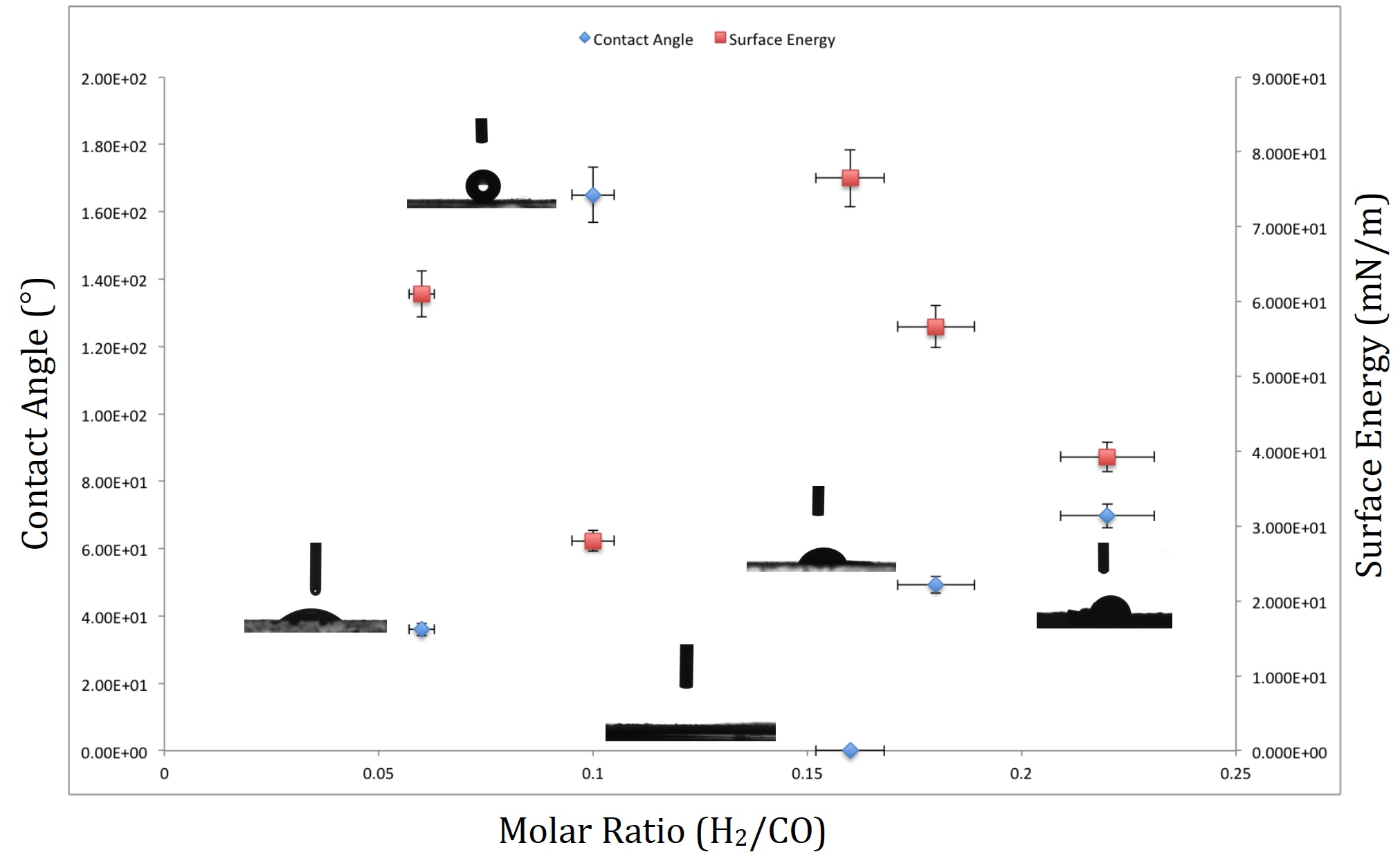Introduction: Despite all the distinctive properties of carbon nanotubes (CNTs), their commercial use in biomedical applications is limited by their cytotoxicity [1]. Several factors can explain the CNT cytotoxicity including their dimension, surface hydrophobicity and degree of agglomeration [1],[2]. However, the effect of surface energy on the cytotoxicity of single wall carbon nanotubes (SWCNTs) has to be investigated further. For this purpose, well-characterized SWCNTs bearing similar functionalities with properties ranging from super-hydrophobic to super-hydrophilic must be prepared. In this study, photo-initiated chemical vapor deposition (PICVD) using a syngas precursor [3] was applied to SWCNTs and is presented as a viable technique to fulfill this goal.
Materials and Methods: Raw-SWCNTs (R-SWCNTs) were first purified by a multi-step protocol as previously described [4]. Efficiency of purification was assessed by transmission electron microscopy (TEM) and thermogravimetric analysis (TGA). These purified SWCNTs (P-SWCNT) were then dispersed in ethanol via sonication and immediately filtered under vacuum upon a polycarbonate membrane. The resulting “buckypaper” was placed in a vacuum oven to ensure complete ethanol evaporation.
The surface of SWCNTs was then treated according to a method developed by Dorval Dion et al (2014) [3]. Briefly, P-SWCNTs were placed inside a UVC-illuminated quartz micro-reactor. After inert gas purging, the syngas precursor (CO and H2) was introduced at various ratios along with H2O2 as a radical photo-initiator (PI). To obtain the desired surface functionality, the process could be implemented under pressure (+15 kPag) or slight vacuum (-15 kPag). Hydrophilic surfaces were typically obtained under slight vacuum, while hydrophobic surfaces were achieved under pressure [3]. The surface energy of the treated P-SWCNTs was determined by applying the Owens-Wendt model [5].
Results and Discussion: TEM was used to both confirm the efficiency of the purification protocol and assess the morphology of P-SWCNTs after treatment. As shown Fig. 1A, the impurities in R-SWCNTs included amorphous and graphitic carbon, as well as catalytic metal nanoparticles, while these impurities in P-SWCNTs were decreased (Fig. 1B) (from 29% to 14% based on TGA results).
Surface wetting of SWCNT samples was assessed through sessile drop contact angle measurements. The average contact angle of P-SWCNT samples was 79±2°, while it varied from 0+3° to 165±3° for treated nanotubes (T-SWCNTs) as a function of the molar ratio of H2/CO (Fig. 2).
Conclusion: Using PICVD with a syngas precursor, we successfully functionalized P-SWCNTs bearing various oxygen-containing groups with properties ranging from superhydrophilic to superhydrophobic. This PICVD method will be helpful to better determine the effect of surface energy on the cytotoxicity of SWCNTs bearing similar functionalities.

Fig. 1. TEM images of A) R-SWCNTs, B) P-SWCNTs.

Fig. 2. Blue lozenge) Contact angle measurements of T-SWCNTs obtained by tensiometry in terms of molar ratio of H2/CO, Red Square) Surface energy measurements that have been plotted in terms of molar ratio.
This project is supported by FRQNT Foundation
References:
[1] He, H.; Pham-Huy, L. A.; Dramou, P.; Xiao, D.; Zuo, P.; Pham-Huy, C., Carbon nanotubes: applications in pharmacy and medicine. Biomed Res Int 2013, 578290.
[2] Alinejad, Y.; Faucheux, N.; Soucy, G., Preosteoblasts behavior in contact with single-walled carbon nanotubes synthesized by radio frequency induction thermal plasma using various catalysts. Journal of applied toxicology : JAT 2013, 33 (10), 1143-55.
[3] Dorval Dion, C. A.; Raphael, W.; Tong, E.; Tavares, J. R., Photo-initiated chemical vapor deposition of thin films using syngas for the functionalization of surfaces at room temperature and near-atmospheric pressure. Surface and Coatings Technology 2014, 244, 98-108.
[4] Kim, K. S.; Imris, M., Shahverdi, A., Alinejad, Y., Soucy, G., Single-Walled Carbon Nanotubes Prepared by Large-Scale Induction Thermal Plasma Process: Synthesis, Characterization, and Purification. J. Phys. Chem. C 2009, 113, 4340–4348.
[5] Yang, L.; Li, Y.; Sheldon, B. W.; Webster, T. J., Altering surface energy of nanocrystalline diamond to control osteoblast responses. J. Mater. Chem. 2012, 22 (1), 205-214.